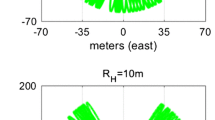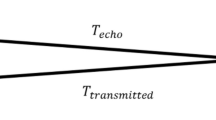Abstract
To counter the problem of acquiring and processing huge amounts of data for synthetic aperture radar (SAR) using traditional sampling techniques, a method for sparse SAR imaging with an optimized azimuthal aperture is presented. The equivalence of an azimuthal match filter and synthetic array beamforming is shown so that optimization of the azimuthal sparse aperture can be converted to optimization of synthetic array beamforming. The azimuthal sparse aperture, which is composed of a middle aperture and symmetrical bilateral apertures, can be obtained by optimization algorithms (density weighting and simulated annealing algorithms, respectively). Furthermore, sparse imaging of spectrum analysis SAR based on the optimized sparse aperture is achieved by padding zeros at null samplings and using a non-uniform Taylor window. Compared with traditional sampling, this method has the advantages of reducing the amount of sampling and alleviating the computational burden with acceptable image quality. Unlike periodic sparse sampling, the proposed method exhibits no image ghosts. The results obtained from airborne measurements demonstrate the effectiveness and superiority of the proposed method.
Similar content being viewed by others
References
Bao Z, Xing M D, Wang T. Radar Imaging Technology. Beijing: Publish House of Electronics Industry, 2005
Cumming I, Wong F. Digtial Processing of Synthetic Aperture Radar Data: Algorithms and Implementation. Boston: Artech House, 2005
Huan Y F, Wang J F, Tan Z, et al. SAR imaging based on compressed sensing. In: IGARSS, Vancouver, 2011. 1674–1677
Baraniuk R, Steeghs P. Compressive Radar Imaging. In: IEEE Radar Conference, Boston, 2007. 128–133
Quan Y H, Zhang L, Guo R, et al. Generating dense and super-resolution ISAR image by combining bandwidth extrapolation and compressive sensing. Sci China Inf Sci, 2011, 54: 2158–2169
Li M Q, Kou J S. The schema deceptiveness and deceptive problems of genetic algorithms. Sci China Inf Sci, 2001, 44: 342–350
Su T, Ling H. Array beamforming in the presence of a mounting tower using genetic algorithms. IEEE Trans Anten Propag, 2005, 53: 2011–2019
Kennedy J. Dynamic-probabilistic particle swarms. In: Proc. of Genetic and Evolutionary Computation Conference, Washington, 2005. 201–207
Murino V, Trucco A, Regazzoni C S. Synthesis of unequally spaced arrays by simulated annealing. IEEE Trans Signal Process, 1996, 44: 119–123
Yu Y L, Wang Y M. Beam pattern optimization using MVDR and simulated annealing. In: 5th IEEE International Symposium on Service Oriented System Engineering, Nanjing, 2010. 117–120
Zhang G Y. Principles of Phased Array Radar. Beijing: National Defense Industry Press, 2009
Zeng C, He X H, Liao G S, et al. Subarray multibeamforming with symmetric exponentially spaced array. Syst Eng Electron, 2009, 31: 2294–2298
Author information
Authors and Affiliations
Corresponding author
Rights and permissions
About this article
Cite this article
Zeng, C., Wang, M., Liao, G. et al. Sparse synthetic aperture radar imaging with optimized azimuthal aperture. Sci. China Inf. Sci. 55, 1852–1859 (2012). https://doi.org/10.1007/s11432-012-4604-9
Received:
Accepted:
Published:
Issue Date:
DOI: https://doi.org/10.1007/s11432-012-4604-9




